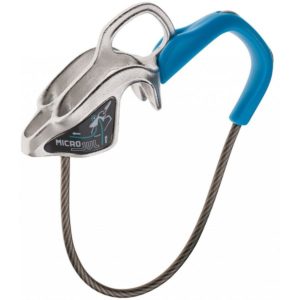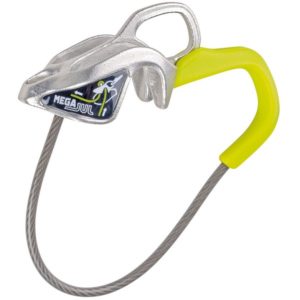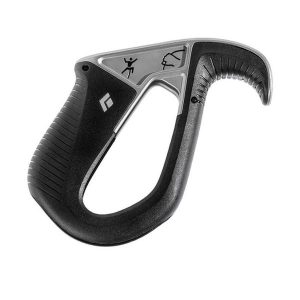Deciding what belay device to choose can be somewhat tricky for the new climber, so we’ve helped clarify the differences and best options below. Recommendations are unbiased and the buying links are affiliate links—purchases made from them support our free content.
Last update: July 10, 2020. Get our climbing newsletter for a weekly dose of awesome content and check out our deals page for today’s best sales.
Elements of a belay device
There exists some debate over which style of belay device is the best first purchase. While assisted braking belay devices such as the Petzl GRIGRI 2 have a built-in mechanism to help catch the climber in the event of a fall, many feel that ATC devices (which stands for Air Traffic Controller) are a better starting spot to ensure appropriate belay technique. This is because with an ATC you have no assistance to catch a fall, so the belayer has no room for error and must practice perfect belay technique. GRIGRIs—while offering an assisted-braking security—can, at times, lead to less attentive belaying.
Choosing the right belay device for you
Our recommendation is to learn from an expert or in an AMGA-certified course and try to get experience on both devices before making a decision. If the budget affords it, many climbers carry one of each device, because although a GRIGRI 2 is excellent for belaying, an ATC is typically required for rappels.
ATCs such as the Petzl REVERSO 4 (pictured below) also include a mode called Guide or Reverso mode. This is used when belaying a second climber, and if you foresee yourself to soon be climbing outdoors and lead climbing than we recommend a device with this capability.

Belay device overview
Belay devices come in all sorts of sizes, shapes, and styles. With the overwhelming amount of devices available on the rock climbing gear market, we’ve narrowed down the ten best belay devices to consider for different situations.
Belay device specs to pay attention to:
DIAMETER: Which diameters of climbing rope can the belay device safely use? This can vary depending on the type of rope being used, but having a greater range allows for a belay device to be less specialized.
WEIGHT: How heavy or light is the belay device? No rock climber wants to haul up more weight than needed, but sometimes there’s a trade off between the weight of a belay device and its performance.
TYPE: There are two types of belay devices: assisted braking and tubular braking. If a device is tubular braking and the belayer is knocked unconscious or not paying attention, then there is nothing keeping the climber from hitting the ground. While not foolproof, assisted braking devices have greater likelihood of not dropping climbers in the same scenarios. Assisted braking devices – excluding the Petzl GRIGRI and Wild Country Revo – work by creating a higher degree of friction than tubular devices through the carabiner, pinching the rope between the device. The aforementioned devices work slightly differently.
With all belay devices, it is important to receive proper instruction on using the device safely. Belaying is, after all, an extremely important part of rock climbing. If you mess up belaying you can end someone’s life, so it is not something to take lightly. Most rock climbing gyms offer courses on using a variety of belay devices, and many of these courses are inexpensive or even free.
Regardless of the belay device you use, always remember to keep your brake hand on the rope! Always!
Our Top Picks for Belay Devices
Cheapest Model:
DMM Mantis
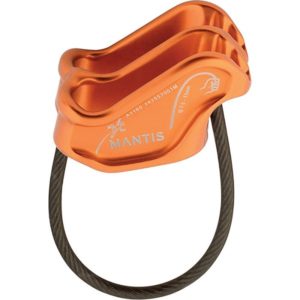
- Assisted Braking or Tubular: Tubular
- Retail Price: $22
- Weight: 45g
- Rope Range: 7.3-9.2mm half/twin rope range, 8.5-11mm single rope range
The DMM Mantis is the least expensive in our review, but that low price tag comes with a catch. The variety of use of the Mantis is limited, as it can only belay and rappel. It cannot belay a climber from above and has no assisted braking mechanism. This makes it less useful for climbers doing more than just basic cragging, however if you don’t want to break the bank, it is an option worth exploring. Of the less expensive belay devices on the market, the Mantis still has a high degree of quality and feeds rope very efficiently and smoothly.
Trad Climbers’ Favorites:
Petzl Reverso
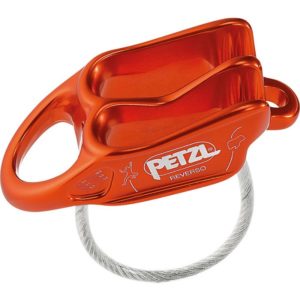
- Assisted Braking or Tubular: Tubular
- Retail Price: $32
- Weight: 57g
- Rope Range: 8.5-10.5mm single, 7.1-9.2mm half, 6.9-9.2mm twin
The Petzl Reverso is a popular go-to belay device. It works with a great rope range, weighs almost nothing, and can also belay in guide’s mode. Additionally, it comes in purple, which is definitely exciting. For not much more money than the Mantis, climbers can get a device that has increased functionality in a very compact package. Despite the small package, it has great catching ability for a tubular belay device, keeping confidence high. One downside is lowering a climber in guide’s mode. On the newer Reverso, Petzl decreased the lowering hole diameter, making it much harder to fit many slings into it and lower someone. Unless you carry skinny dyneema slings or have a cordelette, the normal lowering method for guide’s mode is not an option here. Remember, always look for professional instruction on how to lower someone from guide’s mode – countless accidents could have been avoided if people knew how to lower properly from above.
DMM Pivot
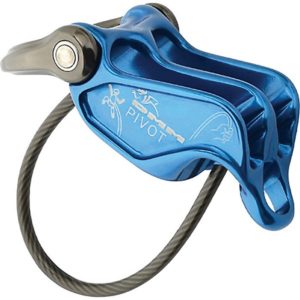
- Assisted or Tubular: Tubular
- Weight: 72g
- Retail Price: $34
- Rope Range: 8.7-11mm single, 7.3-9.2mm half/twin
The DMM Pivot is another great option for trad climbers. Like the Reverso, it can be used for belaying, rappelling, and belaying a second in guide’s mode. While its rope range is not quite as good as the Reverso, the increased ease in lowering climbers makes it a great device to look into. This is accomplished through a pivoting attachment point on the back of the device, and a large diameter lowering hole on the front. It is large enough to accept many carabiners. It does not, however, come in purple. This may be the Pivot’s only setback and therefore makes it a worthy competitor when compared to the Reverso.
For skinny ropes:
Edelrid Micro Jul / Edelrid Mega Jul
- Assisted or Tubular: Assisted
- Retail Price: $40
- Weight: 62g
- Rope range: 6.9-8.9mm
With the ever-increasing popularity of skinnier and skinnier climbing ropes, it is becoming harder to safely catch partners when they fall. This is why the Microjul (or its slightly bigger brother, the Megajul) are terrific options for climbing on twin and half ropes. For a slight increase in weight, you’ll get a catching package that leaves your partner confident–and not worrying that you’ll catch their epic whipper. The device has some flaws, including rappelling and belaying in guide’s mode being slightly obnoxious. Additionally, learning how to use its assisted braking method takes practice. This device is definitely oriented more toward the alpinist and ice climber, where twin and half ropes are used more frequently. If you are climbing solely at the crag, there are much better devices out there, as listed below.
Assisted Braking without breaking the bank:
Black Diamond ATC Pilot
- Assisted or Tubular: Assisted
- Retail Price: $45
- Weight: 92g
- Rope Range: 8.7-10.5mm single
Geometric belay devices are becoming all the rage recently, and for good reason. Without being expensive, they increase the safety standard of belaying that many climbing gyms are starting to require. With the abundance of styles of this type of device, the ATC Pilot reigns high above many competitors. Compared to others in the same field, it feeds slack fluidly, something that many assisted braking devices lack. In its compact package, it also lowers much better than something like the Megajul or Gigajul, leading to a great device for gym climbing and cragging. It cannot be used for rappelling or belaying in guide’s mode, so compared to the Gigajul its range of use is a little limited. Otherwise, for less than half the price of a GRIGRI, you are purchasing a quality device for sport climbing.
Mammut Smart 2.0
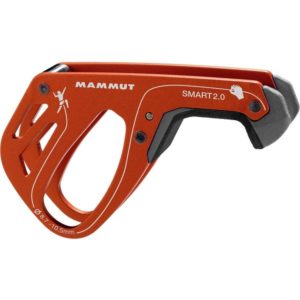
- Assisted or Tubular: Assisted
- Retail Price: $45
- Weight: 80g
- Rope Range: 8.7-10.5mm single
On paper, it looks like the Mammut Smart 2.0 is identical to the Black Diamond Pilot. It almost is, however it doesn’t give slack nearly as smoothly, and lowering is slightly more difficult than with the Black Diamond Pilot. Despite this, it is still a phenomenal device to try. There is a greater color range available that lets you personalize your equipment a little more than the classic Black Diamond “black on black.” Also, the Smart 2.0 goes on sale much more frequently, letting you get an assisted braking device for as little as $25. It is almost impossible to pass up that opportunity when it arises.
Sport Climbing:
Petzl GriGri
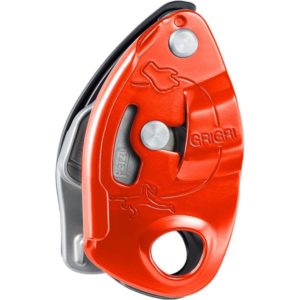
- Assisted or Tubular: Assisted
- Retail Price: $110
- Weight: 175g
- Rope Range: 8.5-11mm single
Perhaps one of the most well-known belay devices on the market, the Petzl GriGri has been popular since it was created. It does take some time to get used to lead belaying with it, but once the technique is learned, not many devices compare to a GriGri. For the GriGri to lock, an internal cam rotates to pinch the rope into place. This only occurs when the rope is moving quickly through the device (caused by a falling climber). Otherwise, belaying is fairly smooth and fluid. Inexperienced climbers are more likely to short-rope (not give rope fast enough to someone pulling out slack to clip into a piece), and this can be a cumbersome aspect of Petzl’s most popular product. A bonus of a GriGri is the fact that most experienced climbers know how to use one, so if they (or you) forget a belay device you won’t have to explain how to use a newer style device. For projecting and smoothly giving slack to your climber, not many belay devices compare to a GriGri. It can belay in guide’s mode off an anchor as well, which is something that the ATC Pilot and Smart 2.0 cannot do. The functionality of the GriGri is part of the reason it is such a popular device. Do keep in mind that you cannot rappel a double stranded rope with a GriGri, which requires you to bring two devices while multi-pitch climbing or knowing some nifty rope tricks to rappel single stranded.
Wild Country Revo
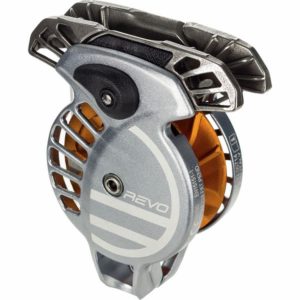
- Assisted or Tubular: Assisted (but read more below!)
- Retail Price: $145
- Weight: 245g
- Rope Range: 8.5-11mm single
The Wild Country Revo requires a fair bit of explanation. While we list it as assisted braking, that technically isn’t the case. Nor is it solely a tubular belay device. Ultimately, it functions as a tubular belay device with a backup feature. This means that if you belay with perfect tubular braking technique, then the device’s backup won’t lock when a climber falls. If you accidentally have too much slack in the system or are knocked unconscious while belaying, then the backup engages. The benefit of the Revo is giving slack, which is much easier than with a GriGri. Your partner will not yell at you for short-roping them nearly as much with the Revo. We find that the trad climber turned sport climber really appreciates this device, as it works practically the same as an ATC. If someone is projecting a route and hanging on the rope for awhile, engaging the locking feature can be a little finicky, making the Revo better for redpoint burns.
The one that does it all:
Edelrid Giga Jul
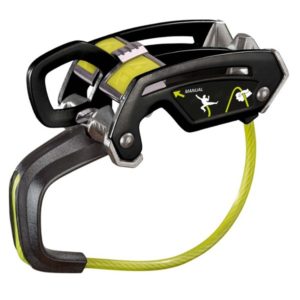
- Assisted or Tubular: Both
- Retail Price: $50
- Weight: 120g
- Rope Range: 7.1-10mm
We’ve already reviewed the Edelrid Giga Jul here, but in summary, the Giga Jul can do just about everything. Due to a sliding bar in the middle of the device, you can choose whether it is assisted braking or tubular braking. This is especially important if you want only one belay device for everything, or prefer a tubular device (except for at the climbing gym where they require an assisted braking device). It can rappel and belay in guide mode, and works with twin, half, and single ropes. While it doesn’t truly excel in any specific department, it perhaps has the most bang for its buck, given its versatility.
Explore More
Related articles you'll loveReview of the Best Shoes for Bouldering, Sport, and Trad
Free Rock Climbing eBooks on Technique, Knots, Training, and More
Gear Guide: Sport Climbing Essentials
Gear Guide: Best Climbing Equipment for Beginners
6 Best Training Recovery Tools for Climbers
Our 30+ most popular articles ever
Community Discussion: Most Popular Climbing Shoes
23 Best Gifts for Rock Climbers
Get daily content updates by Liking us on Facebook

